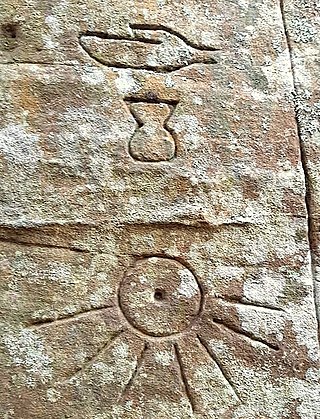Fujimura Shinichi is a Japanese amateur archaeologist who claimed he had found a large number of stone artifacts dating back to the Lower Paleolithic and Middle Paleolithic periods. These objects were later revealed to be forgeries.

Archaeological forgery is the manufacture of supposedly ancient items that are sold to the antiquities market and may even end up in the collections of museums. It is related to art forgery.

The Japanese Paleolithic period is the period of human inhabitation in Japan predating the development of pottery, generally before 10,000 BC. The starting dates commonly given to this period are from around 40,000 BC; although any date of human presence before 35,000 BC is controversial, with artifacts supporting a pre-35,000 BC human presence on the archipelago being of questionable authenticity. The period extended to the beginning of the Mesolithic Jōmon period, or around 14,000 BC.

The Iwajuku site an archaeological site located in what is now the Kasuke neighborhood of the city of Midori, Gunma Prefecture in the northern Kantō region of Japan with finds from the Japanese Paleolithic period. It received protection as a National Historic Site in 1979.
Mitsuo Kagawa was a Japanese archaeologist and a professor at Beppu University in Ōita Prefecture, Japan. He committed suicide by hanging himself on March 9, 2001, as a result of the Japanese Paleolithic hoax.
The Hong Kong Archaeological Society is a government-funded organization dedicated to carrying out excavations and preserving archaeological heritage in Hong Kong. The society is affiliated with the Hong Kong Museum of History to establish artifact collections and journal publications.

The Tōhoku History Museum is a museum in Tagajō, Miyagi Prefecture, Japan. It houses finds from excavations at the site of Tagajō as well as from other archaeological sites in the Tōhoku region of northern Japan.

The Ōdai Yamamoto I Site is a Jōmon archaeological site in the town of Sotogahama, Aomori Prefecture, in the Tōhoku region of northern Japan. Excavations in 1998 uncovered forty-six earthenware fragments which have been dated as early as 14,500 BC ; this places them among the earliest pottery currently known. As the earliest in Japan, this marks the transition from the Japanese Paleolithic to Incipient Jōmon. Other pottery of a similar date has been found at Gasya and Khummi on the lower Amur River. Such a date puts the development of pottery before the warming at the end of the Pleistocene.

The Togariishi Museum of Jōmon Archaeology is a municipal museum located in the city of Chino, Nagano Prefecture, Japan, specializing in artifacts of the Jōmon period.

The Korekawa Site is an archaeological site in the city of Hachinohe, Aomori Prefecture, in the Tōhoku region of northern Japan containing the ruins of a middle to late Jōmon period settlement. The remains were designated a National Historic Site in 1957 by the Japanese government. It is also referred to as the "Korekawa Stone Age site", although the remains discovered are from the Jōmon period, rather than the Japanese Paleolithic period.

The Kamegaoka Site is an archaeological site in what is now part of the city of Tsugaru, Aomori Prefecture, in the Tōhoku region of northern Japan, containing the ruins of a Jōmon period settlement. The remains were designated a National Historic Site in 1944 by the Japanese government. It is also referred to as the "Kamegaoka Stone Age Site", although the remains discovered are from the final Jōmon period, rather than the Japanese Paleolithic period, as the name would imply. It is located approximately 20 minutes by car from Goshogawara Station.
The Uenodan stone age ruins is an archaeological site containing the ruins of a Jōmon period settlement located in the Kitayama-Yukawa neighborhood of the city of Chino, Nagano in the Chūbu region of Japan. The site was designated a National Historic Site of Japan in 1942.

The Moro Heritage Site, shown on some maps as Moro Heritage or Moro Archaeological Site, is an archaeological site where stone tools from the Paleolithic Age were found in Itabashi Ward, Tokyo, Japan.

The Yuzurihara Stone Age Residence Site is an archaeological site with the ruins of a Jōmon period settlement, located in what is now part of the city of Fujioka, Gunma Prefecture in the northern Kantō region of Japan. The site was designated a National Historic Site of Japan in 1948.
The Takizawa Stone Age Site is an archaeological site containing the ruins of a Jōmon period settlement located in what is now the Akagi neighborhood of the city of Shibukawa, Gunma Prefecture in the northern Kantō region of Japan. The site was designated a National Historic Site of Japan in 1927.
The Minakami Stone Age Residence Site is an archaeological site with the ruins of a Jōmon period settlement, located in what is now part of the town of Minakami, Gunma Prefecture in the northern Kantō region of Japan. The site was designated a National Historic Site of Japan in 1944.

The Koma Village Stone Age Dwelling Site is an archaeological site in the city of Hidaka, Saitama Prefecture, in the Kantō region of Japan containing a Jōmon period settlement ruin. The site was designated a National Historic Site of Japan in 1951.
The Isehara Hachimandai Stone Age Dwelling Site is an archaeological site containing the ruins of a Jōmon period settlement located in what is now the Hachimandai neighborhood of the city of Isehara, Kanagawa Prefecture in the southern Kantō region of Japan. The site was designated a National Historic Site of Japan in 1934.
The Tanamukaihara Site is an archaeological site with the ruins of a Japanese Paleolithic period settlement located in the Tanashioda neighborhood of Chūō-ku, Sagamihara, Kanagawa Prefecture in the southern Kantō region of Japan. It was designated a National Historic Site in 1999.

The Suarashi Stone Age Site is an archaeological site in the Suwarashi neighborhood of Midori-ku, Sagamihara, Kanagawa Prefecture, in the southern Kantō region of Japan containing a late Jōmon period settlement trace. It was designated a National Historic Site of Japan in 1930.











